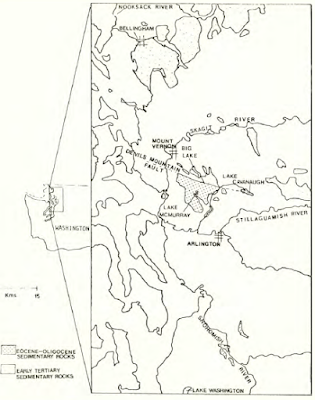I have had several ventures on the steep north slope of Mount Frailey above Lake Cavanaugh in Skagit County. These ventures were to assess alluvial fan hazards which has meant assessing the steep drainages above the alluvial fans. Like much of the Northwest Cascades bedrock exposures are sometimes limited to stream channels. Hence the steep drainages on the north side of Frailey Mountain provided a good opportunity to see the bedrock hiding under the thick forest landscape. The lower slopes of Mount Frailey are underlain by sedimentary rocks called Rocks of Bulson Creek.
Conglomerate of Bulson Creek
Note weathered perimeter of greenstone cobble
The hard conglomerate of the formation forms cliffs and a few nice cascades on the stream Bob and I were exploring. The clasts in the conglomerate are derived from nearby metamorphic rocks of the Eastern Mélange Belt which is well exposed on the slope above this outcrop. The Eastern Mélange Belt consists of Triassic to Jurassic age ocean floor terrane thrust up onto the edge of North America. It is one of several accreted terranes in the Northwest Cascades.
The Rocks of Bulson Creek are Oligocene to Eocene and post date the terrane accretion. The Bulson appears to be deposited on the metamorphic rocks (Marcus, 1981) and appears to be a localized sedimentary in a localized basin that formed during the late to post Eocene time likely associated with the Devils Mountain-Darrington Fault (Lovseth, 1975 and Marcus, 1981). In the Lake McMurray area to the east the Bulson has clasts of Eocene to Oligocene volcanic rocks that are of local derivation.
Distribution of Rocks of Bulson Creek from Marcus (1981)
Lovseth (1975) recognized the Bulson as a separate sedimentary unit than the similar looking Chuckanut Formation to the north. The Bulson is primarily marine while the Chuckanut is non marine. And while the base of the Chuckanut does contain locally derived clasts of Northwest Cascades rocks, most of the Chuckanut sediment is derived from a source area to the east of the Cascade Mountains at a time prior to the uplift of the range.
The term Rocks of Bulson Creek is from Bulson Creek located along a section of the Devils Mountain-Darrington Fault Zone. The creek incises down through the rocks and providing good exposures of a section of the formation. On the day of my venture up Frailey Mountain I also had a project along Bulson Creek and got a view of Bulson Creek Falls over a layer of hard conglomerate.







No comments:
Post a Comment